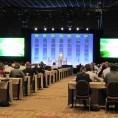Look down at your phone, look up at your computer, or even just glance around your office. Virtually every aspect of our lives – and nearly every interaction and workplace object contained within them – has been dramatically changed by the advent of technology. As we point out in recent bestseller The Business Etiquette Bible, it’s important for those hoping to lead and succeed in tomorrow’s business world to be aware of how high-tech solutions and apps are fundamentally reshaping the way we connect with and engage others. It’s a topic we’ll explore more closely here in a new series of articles about how to more effectively communicate and inspire others in an age of 24/7 online connectivity.
Think about it. If you were just turning 18 today, brick-sized “portable” cell phones, PCs running on rudimentary Internet connections (or even modems) and televisions without time-shifting digital video recorders (DVRs) would have been the norm the year you were born. Today, smartphones offering constant online connectivity, tablet PCs featuring cloud computing services that place an entire desktop’s worth of productivity apps in your carry-on, and professional social networks that instantly connect you with thousands of people worldwide are just a single tap away.
Technology used to tie you down, but now it frees you – or at least appears to do so, at a passing glance. But dig deeper and you’ll soon discover the growing challenge that today’s modern businesses, and businesspeople, are rapidly becoming all too aware of: For every new opportunity that innovative apps, gadgets and software programs introduce, they also present new wrinkles. With Twitter, Facebook and LinkedIn becoming a bigger part of everyday life, Google searches commonplace when researching new hires or prospective strategic partners, and the ability to post photos, videos and status updates online on-demand from virtually anywhere growing, there’s no doubt that technology has become interwoven through every part of our personal and professional lives. But with great power comes the responsibility to be increasingly aware of the software and devices we use within the commercial world, how we utilize them, and the way in which our online and high-tech interactions impact others.
Case in point: Nowadays, it’s not uncommon to witness twenty-somethings out for a business lunch who will suddenly pause their discussions mid-conversation and whip out their cell phones to check a new text message. Or, for that matter, high-powered salespeople merrily chattering away with contacts and connections while an airplane sits preparing for liftoff on the runway. Modern workdays, like the boundaries between jobs and personal time, are also increasingly blurring, given that our mobile devices are many times as powerful as yesterday’s computers, and we’re literally carrying our business around with us in our pockets. We’re not only overwhelmed by the wealth of media options suddenly available on mobile devices, Web browsers and through broadband connections – we’re increasingly struggling to comfortably incorporate them into our careers and professional interactions.
As is evident at a glance, these new high-tech problems are most reflected when it comes to modern etiquette and manners. These troubles aren’t a passing issue confined solely to tech enthusiasts, either: More than a billion normal, everyday individuals (a great number of them working professionals) currently utilize Facebook, several hundred million connect via Twitter, and, according to CTIA – The Wireless Organization, there are now more cell phones than people in America. Moreover, the Radicati Group says that at least one out of every five people uses e-mail, and the Pew Institute found that the same amount have read an e-book over the past year. Just one problem: As popular as many of these forms of technology are today, they existed in very different forms two decades ago, if they existed at all. No wonder we’re unsure how to handle them!
This is where the following range of articles – together, a comprehensive training guide to business “netiquette” (online and high-tech etiquette) – comes in. Designed to answer as many burning questions as possible, the series aims to decode the rules of high-tech courtesy and behavior for a new generation of working professionals. An open-ended guide to manners in the age of persistent connectivity, social networks and streaming media, we’ve also connected with a slew of modern-day tech experts (our generation’s equivalent of Ann Landers) to get their inside hints, tips and advice on how to comport yourself in the 21st century.
Note that given the pace at which technology moves, the endless (and endlessly evolving) variety of global and professional cultures that exist, and unique ways in which each individual interacts with high-tech tools, these proposed rules are merely a conversational starting point. Offering general guidelines and discussion points for experts and enthusiasts to discuss and debate, we hope that they’ll provide positive suggestions that can help enhance both your interactions with others and the way in which you interface with technology itself. Only through ongoing and evolving dialogue between educators, employers, lawmakers, certified training professionals, professional associations and everyday individuals alike can we hope to truly define formal rules of online or high-tech conduct and digital citizenship. But in the interests of providing a starting guidepost to navigating the increasingly complex web of high-tech gadgets and services, and growingly sophisticated range of interactions and communications surrounding them, we hope you’ll find it a welcome introduction.
For working professionals, we hope to demonstrate the best way to maintain professionalism and integrity within your field and/or on your chosen career path, and avoid the many unexpected but often arresting faux pas that could unexpectedly halt your journey. For businesses, organizations and employers, we seek to set initial training, education and workplace guidelines that will allow you to create a positive, safe, and enriching environment for your employees. For purposes of clarity and succinctness, we’ll break the realm of high-tech and online etiquette down into ten core topics, covered throughout various articles on our site:
- Social Networks
- Cell Phones, Tablets, Electronics, and Mobile Devices
- Videoconferencing
- Blogs, Websites, and Online Newsgroups
- Corporate Blogging and Social Media Outreach
- Marketing, Public Relations and Social Campaigns
- Job Hunting and Careers
- Internet and Online Safety
- Instant Messaging and Chat Rooms
Each article will provide the information that you or your business needs to know in order to adroitly handle yourself in everyday situations. As an added bonus, we’ve also sprinkled in interviews and insights with leading etiquette experts, relevant discussion points of interest, and (for all you newcomers) definitions of common tech lingo. We invite you to submit your own insights, tips and suggestions at www.AKeynoteSpeaker.com – only with your help and insight can we hope to keep future generations ahead of the curve.
For more on these topics, also be sure to grab your copy of The Business Etiquette Bible today!














